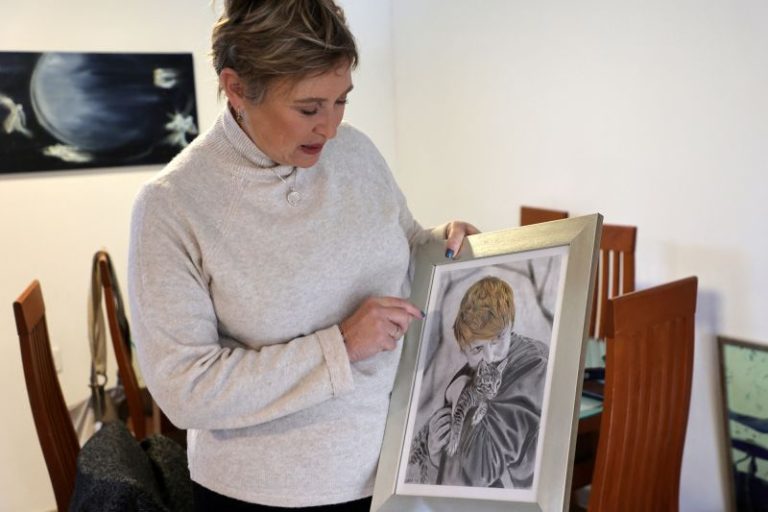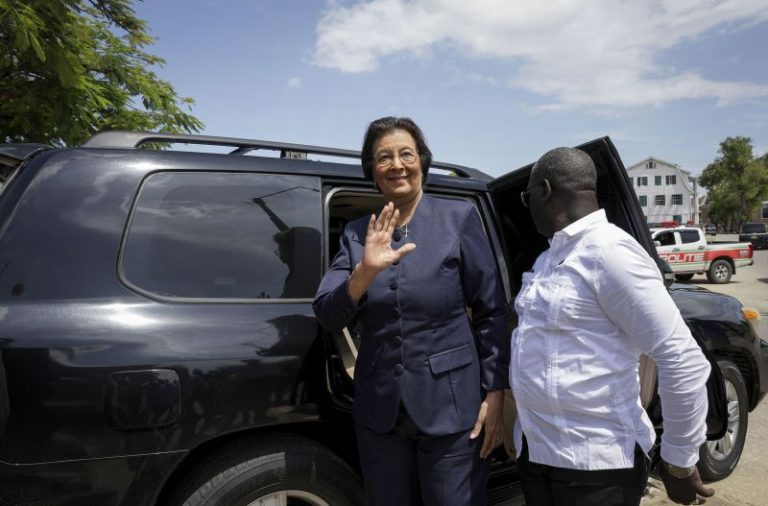“Something can be born out of everything – if you want it to,” said Iris Haim, whose hostage son Yotam was killed in Gaza. Those words are helping her find hope.
The new beginning that Haim now longs for is a grandchild, created from sperm she had harvested from Yotam’s body upon its return home in December 2023.
Yotam, 28, was kidnapped by Hamas-led militants from kibbutz Kfar Aza on October 7, 2023. After spending 65 days in captivity, he was mistakenly shot by Israeli troops on December 15, 2023 along with two other hostages, Alon Shamriz and Samer Talalka, as they attempted to flee their captors in northern Gaza.
Yotam is the only Israeli hostage whose sperm is known to have been retrieved posthumously, and whose family is lobbying to use it to have a child.
Haim says Yotam, a single man at the time of his death, always wanted children. “Yotam really wanted that – he talked about it a lot,” she said.
A total of 205 hostages have so far been returned, 148 of whom were released alive, and 57 returned dead, according to Prime Minister Benjamin Netanyahu’s office. Most had been dead for weeks, if not months, making the men’s sperm no longer viable for use – except for Yotam’s. That’s where his mother saw an unexpected opportunity to have what would be her first grandchild.
Chances of successful sperm retrieval are highest in the first 24 hours after death, with the cut-off time being 72 hours, according to the Israeli government.
There are currently 50 Israeli hostages held in Gaza, of whom at least 20 are believed to be alive. Both Hamas and Israel have accepted a new ceasefire proposal and indirect negotiations on a deal have restarted, raising hopes that more could return home soon.
Haim remembers with painful clarity the moment Israeli authorities came to her home and told her about her son’s death. “Yotam was killed. By friendly fire. While escaping Hamas captivity. He was mistakenly identified as a terrorist,” Haim recalled the officers saying.
Half an hour after they broke the news of Yotam’s death, one officer approached Haim and whispered, “you can request sperm retrieval,” Haim said. The process “immediately got started, immediately,” she said.
Yotam’s sperm was retrieved within the necessary window of time. Ten samples were extracted, “enough for five children,” Haim recalled being told by the doctor who performed the procedure.
Haim now faces an uphill battle to get approval to use his sperm to produce a grandchild. If she succeeds, her next challenge would be to find a woman to carry the child and raise it.
Sperm lives on briefly after death, which is why it’s possible for doctors to retrieve it from testicular tissue. Any live sperm cells found are transferred and frozen in liquid nitrogen.
None, however, can be used without approval from a family court, where Haim now faces an uphill battle to continue her son’s lineage.
In Israel, extracting sperm from a dead body is permitted, but there is no law that clearly defines the process of using the sperm for the purpose of producing offspring.
“In Israeli law, we don’t have a law for this procedure,” Nily Shatz, Haim’s lawyer, said, adding that family courts have only approved posthumous use of sperm by parents of the deceased to produce a child twice in the past; however, the second case was later overturned after an appeal brought by the state. “All the other cases were rejected.”
The first case was that of a woman who after years of court battles was able to have a grandchild after proving that her son, who was killed in Gaza in 2002, wanted children, according to Shatz. The court, however, declared that the ruling should not be perceived as a precedent, saying legislators must decide on the matter in the future. The second case was that of a couple who are still fighting in court to have a grandchild with retrieved sperm of their late son, who died in 2012.
Meirav Ben-Ari, a lawmaker in Israel’s parliament, the Knesset, is pushing for a bill that formally allows family members to use retrieved sperm even if the deceased had not specifically stated his wish to have a child posthumously, as long as they can prove the deceased would have wanted a child.
Netanyahu’s coalition is made up of some of the most religiously conservative parties ever to hold power in Israel, including ultra-Orthodox and far-right religious Zionist factions whose agendas are reshaping the country’s legal and social fabric.
Shatz, Haim’s lawyer, said that after the horrors of October 7, it was past time for parliament to pass a law on the issue, especially as families of hundreds of fallen soldiers retrieve the sperm of their dead.
But while Haim longs to be a grandmother, the issue of using the sperm of deceased men remains controversial. It raises ethical, religious and legal questions that lawmakers are yet to address.
For now, cases are assessed individually by the family courts, Shatz said. And since there are varying opinions in government about the practice, each case is viewed with extreme caution, she said.
At the moment, for families to use the sperm of their deceased, they must prove to the courts that the person who died wanted children, even after his death.
Yotam’s family is working to prove that he wanted children by providing testimony from relatives, friends and his therapist, but such intangible proof is likely to be harder for many others to present.
“There’s no logical way (where) usually people say that I want a child, even if I’m going from the world,” Shatz said, noting this isn’t something ordinary men think about, especially when young.
Posthumous sperm retrieval (PSR) in Israel was previously open only to partners – provided other relatives did not object – while parents of the deceased had to apply for legal permission. Following the October 7 attacks, the Ministry of Health loosened the rules.
“In previous years, approximately 15–20 such retrievals were performed annually,” the ministry said.
For Haim, having a grandchild is a way to prove that Israel will keep growing despite the massacre.
“Every mother whose child was killed wants to have something from that child, not just photos. She wants something tangible,” Haim said, her eyes briefly filling with tears. “As the people of Israel, we need to understand today that, after October 7, we need to keep growing – to show our enemies that our way, this continuity of our lives here in this country, and in general, is through the creation of new life.”
“That forces you to be in this situation. That’s what war is doing to us,” he said.
Levine advocates for soldiers to decide early whether they’d like to have children, and for them to preserve their sperm while they are still alive.
Some have also called for soldiers to leave a “biological will,” a testament that lays out an individual’s wishes when it comes to posthumous use of eggs or sperm, whether they are retrieved after death or frozen while the person is still alive.
Bella Savitsky, whose son Jonathan died in combat on October 7, opted to retrieve his sperm and got approval for it, but it came too late.
Savitsky, a senior lecturer in the School of Health Sciences at Ashkelon Academic College, said studies show a maximum of 36 hours since time of death is the only time that retrieved sperm can be usable, a shorter timeframe than that cited by the Israeli government. This window is narrower in Israel because the hot weather can affect the sperm’s quality in dead bodies, she said.
On October 9, 2023, Savitsky received “the knock on the door” from authorities, telling her that her 21-year-old son had been killed in heavy fighting at an army outpost near Gaza.
“He wanted to get married, to have children, a dog, and a home in the countryside.”
It took many hours for Savitsky to obtain a court order allowing the harvesting of her son’s sperm.
“Altogether, it took 70 hours,” she said. “So, when the posthumous sperm retrieval was done, it was not intact. There was no live sperm.”
Sperm retrieval after death undoubtedly raises complex moral, ethical, judicial and religious questions. While technology has advanced, critics say the law has not kept up.
Experts say the controversy stems from the lack of clear consent from the father and the idea of bringing a child into the world who is fatherless from the outset.
“You are bringing into the world a child whose parent is known, named and deceased. This has a significant psychological impact and is different from a single-parent family,” Siegal said.
Some may also object to having children that effectively serve as a monument to the deceased father.
In that case, “the grandparents are seeking a ‘memorial’ – a form of commemoration – or trying to recreate something that cannot be recreated,” Siegal said. There are also religious considerations, as “retrieving sperm is an intrusive act, and in Judaism, there is a critical prohibition against desecrating the dead,” he said.
To mitigate these issues, Savitsky believes that young men should be asked whether they would want their sperm to be posthumously retrieved before they enter army service, but said the ministry of defense may be wary of implementing this as it could dent troop morale.
For Haim, despite the difficulties, the battle to have a grandchild gives her strength in the face of the tragedy she faces after October 7, as well as hope for the future.
In May, the State Attorney’s Office gave a green light in principle for Haim to use Yotam’s sperm. That was a first step towards what may be a long journey for her to have a grandchild. The family still needs to present evidence to prove that Yotam would have wanted a child, Shatz, Haim’s lawyer said.
“In the end, the reality did happen to us on October 7. So now – what will we do with that reality? Cry, wail, say, why did this happen to us?” she asked.
“Yes, a disaster happened. Period. But what else happened? A lot of amazing things also happened. That’s where I’m aiming (for).”
This post appeared first on cnn.com










